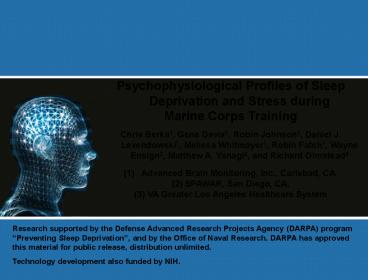Psychophysiological Profiles of Sleep Deprivation and Stress during - PowerPoint PPT Presentation
1 / 16
Title:
Psychophysiological Profiles of Sleep Deprivation and Stress during
Description:
By night 21, the marines average 58 hours of accumulated sleep debt ... Data indicate that Marines do not self-report fatigue, increasing the need for ... – PowerPoint PPT presentation
Number of Views:115
Avg rating:3.0/5.0
Title: Psychophysiological Profiles of Sleep Deprivation and Stress during
1
- Psychophysiological Profiles of Sleep Deprivation
and Stress during - Marine Corps Training
- Chris Berka1, Gene Davis1, Robin Johnson1, Daniel
J. Levendowski1, Melissa Whitmoyer1, Robin
Fatch1, Wayne Ensign2, Matthew A. Yanagi2, and
Richard Olmstead3 - Advanced Brain Monitoring, Inc., Carlsbad, CA,
- (2) SPAWAR, San Diego, CA,
- (3) VA Greater Los Angeles Healthcare System
Research supported by the Defense Advanced
Research Projects Agency (DARPA) program
Preventing Sleep Deprivation, and by the Office
of Naval Research. DARPA has approved this
material for public release, distribution
unlimited. Technology development also funded by
NIH.
2
Introduction Study Goals Rationale
- Assess fatigue and stress and their effects on
situation awareness and decision-making during
28-day USMC Mojave Viper training - Evaluate utility of EEG, EKG, actigraphy in
predicting performance deficits in an operational
setting - Value to USMC
- Better awareness of team capabilities
- Improve safety and mission management
- Fatigue management
3
Challenges of the operational environment
- Mojave Viper training at 29 Palms
- 28-day training event covering all USMC
operations in desert urban environments - Final training prior to deployment in Iraq or
Afghanistan - Main objectives
- 1. Demonstrate that marines experience fatigue
during training using objective measures. - 2. Assess effects of fatigue and/or stress on
performance during training.
4
Methods participants meaures
- N17 platoon, squad fire team leaders
- Continuous actigraphy throughout testing
- Baseline and repeated sessions (1/wk)
- 30-minute EEG, EKG, 3-Choice Vigilance
- Saliva cortisol levels
- Subjective measures
- POMS
- Brief Fatigue Inventory
- Perceived Stress Scale
- Subjective Sleepiness Scale
5
Mobile Wireless EEG System
- No-prep sensors
- Battery-powered
- Automate artifact detect / decon
- EEG sensors at Fz, Cz, POz referenced to linked
mastoids, bipolar Fz-PO and Cz-PO - EKG sensors on collarbone lower rib
- System proved durable in field environment
- Marines quickly learned to self-apply
- No issues with comfort or usability
6
(No Transcript)
7
Results Actigraphy- Sleep Debt
- Sleep debt calculated by subtracting recommended
sleep period (8 h/ 480 min) from actual sleep
minutes. - By night 21, the marines average 58 hours of
accumulated sleep debt
8
Results 3-Choice Vigilance Test
9
Results EEG-based Fatigue indications
10
Results Heart rate/variability
HR/HRV measures Calculated on 5 min. windows
during testing HRV coefficient of variation
based on median Mean HR significantly decreased
at weeks 3 4 Mean HRV significantly increased
at week 4
11
Results Subjective Measures
POMs Vigor significantly decreased at week
4. Marine anger levels were above normal on
POMs. No changes observed in other subjective
measures
12
Addressing the Baseline Problem
- Scheduling morning sessions for baselines is
impossible with USMC at 29 Palms - Approvals from command were obtained just prior
to start of Mojave Viper - A fully-rested, stress-free baseline may be
impossible to obtain from active marines - Potential solutions
- Compare to ABM healthy database (n200)
fully-rested sleep-deprived - Acquire data from fully-rested marines when they
first arrive at Camp Pendleton
13
Results 3C-VT Accuracy Reaction Time
P lt 0.01
USMCS4--
14
Conclusions
- Mobile wireless EEG/HR/HRV acquisition
technologies provide valid objective measures of
fatigue in an operation environment - Data obtained without interfering in ongoing
operations - EEG/HR/HRV assessed during the 3C-VT
quantitatively showed fatigue to be a serious
problem in Marines before deployment - Data indicate that Marines do not self-report
fatigue, increasing the need for objective
measurements of fatigue
15
Relevance of Study Results
- Fatigue in USMC convoy operations is a serious
problem - Estimated 35-50 of US casualties in Iraq occur
during convoy attack - Results suggest feasibility of objective fatigue
assessment in operational settings - Coupled with appropriate interventions fatigue
monitoring could improve safety and save lives
16
Advanced Brain Monitoring, Inc.
- Q A































